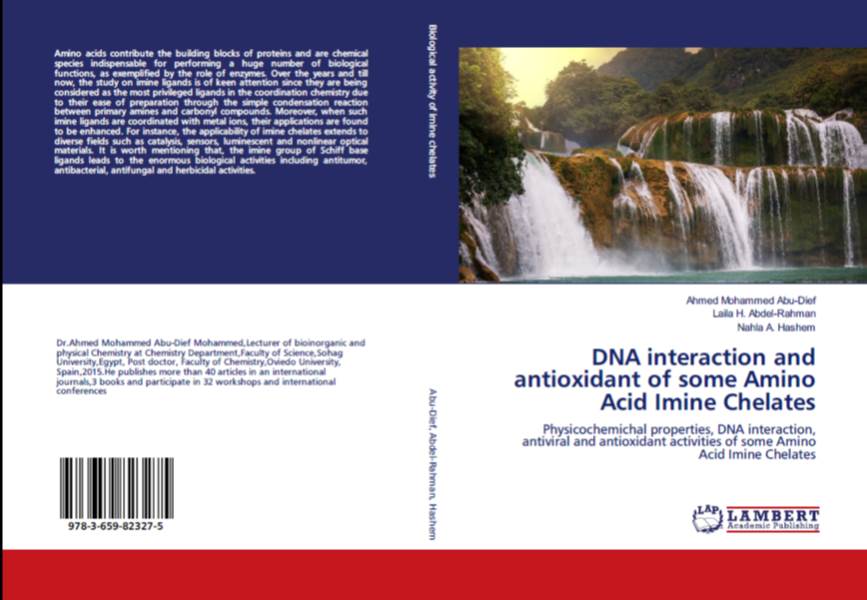Schiff base amino acid ligands which derived from the condensation of 3-methoxysalicylaldehyde (MS) or 4-diethylaminosalicylaldehyde (DS) with some of α-amino acids (Phenylalanine (Phe), Histidine (His), Tryptophan (Trp)) were prepared. Moreover, eleven Schiff base amino acid binary Fe(II) and Cu(II) complexes were prepared. In addition to, five ternary Cu(II) complexes which derived from the prepared Schiff base amino acid ligands as primary ligand and 2, 4-dipridyl (DP) as secondary ligand were prepared. All the prepared ligands were analyzed by 1HNMR, 13CNMR spectra, melting points, elemental analysis, UV-Vis and IR spectra. The prepared complexes were characterized by decomposition temperatures, elemental analysis, UV-Vis, IR spectra, TGA in nitrogen atmosphere, cyclic voltammetry, magnetic moment and conductivity measurements. Moreover, kinetic and thermal parameters of the prepared complexes were computed from the thermal data using Coast and Redfern method. Moreover, the stoichiometry and the stability constants of the prepared complexes have been determined spectrophotometrically. In addition to, the particle size distribution of the prepared complexes was determined by using TEM. The results suggest that the prepared Schiff base amino acid ligands behave as monobasic tridentate ONO ligands and coordinate to M(II) ions in octahedral geometry with 1: 2 (M: L) stoichiometry according to the general formula [M(HL)2].nH2O (except MSHFe complex is (1: 1) (M: L) in which MSH ligand acts as tetradentate ONNO with general formula (NH4+)[Fe(HL)(H2O)SO4]-.2H2O)).
While, the prepared ternary complexes have the general formula [Cu(HL)(Dp)(H2O)(CH3COO)].nH2O. Also, the experimental results of TGA indicated that the investigated binary Fe(II) and Cu(II) complexes do not contain coordinated water molecules (except MSHFe complex). Also, the prepared binary Fe(II) and Cu(II) complexes contain hydrated water molecules except DSPCu and DSPFe complexes. Also, the investigated ternary complexes contain hydrated and coordinated water molecules. Magnetic susceptibility measurements show that the prepared Schiff base amino acid ligands have diamagnetic properties and their complexes are paramagnetic. The molar conductance values of the prepared Schiff base amino acid ligands and their complexes were relatively low (3.8- 43.3 Ohm-1 cm2 mol-1) indicating the non-electrolytic nature of these compounds, except MSHFe complex has a relatively high value (60.3 Ohm-1 cm2 mol-1) which implies electrolyte species. The pH profile revealed that, the wide range of pH stability of the investigated complexes is at pH = 4-10 in most of them. The particle size distribution of most of the prepared complexes was in the range of nanoscale. Moreover, the prepared MST, DSH and DP ligands and their complexes structures were validated using quantum mechanics calculations based on accurate DFT methods. In addition to, the prepared Schiff base amino acid ligands and their complexes were tested against three types of bacteria such as Bacillus subtilis (+ve), Escherichia coli (-ve) and Micrococcus luteus (+ve) and three types of fungi such as Asperagillus niger, Candida glabrata and Saccharomyces cerevisiae. The results of these studies indicate that the prepared complexes exhibit a stronger antibacterial and antifungal efficiency compared to their corresponding ligands. Moreover, the prepared Schiff base amino acid binary Cu(II) complexes were screened for antiviral activity against a panel of DNA (HSV) and RNA (TMV) viruses. Moreover, minimum cytotoxic and minimum virus inhibitory concentrations of these complexes were determined. The results showed that the prepared complexes have relatively high antiviral activities. Moreover, binding of the prepared complexes with CT-DNA was monitored using spectral studies, viscosity and agarose gel electrophoreses measurements. The experimental results indicated that the investigated complexes strongly bind with CT-DNA via intercalative mode. Moreover, antioxidant activities of the prepared Fe(II) complexes were investigated by using the ABTS assay and the results showed that their antioxidant activity follows the sequence MSHFe > MSTFe > DSTFe > MSPFe > DSHFe > DSPFe. Furthermore, catalytic activities of prepared binary and ternary Cu(II) complexes towards the oxidation of benzyl alcohol using H2O2 as oxidant were investigated. Different reaction parameters (such as separation time, temperature and effect of solvent) were studied in this reaction and the results indicate that the prepared Schiff base amino acid binary and ternary Cu(II) complexes exhibit low to medium activity towards the oxidation of benzyl alcohol.


